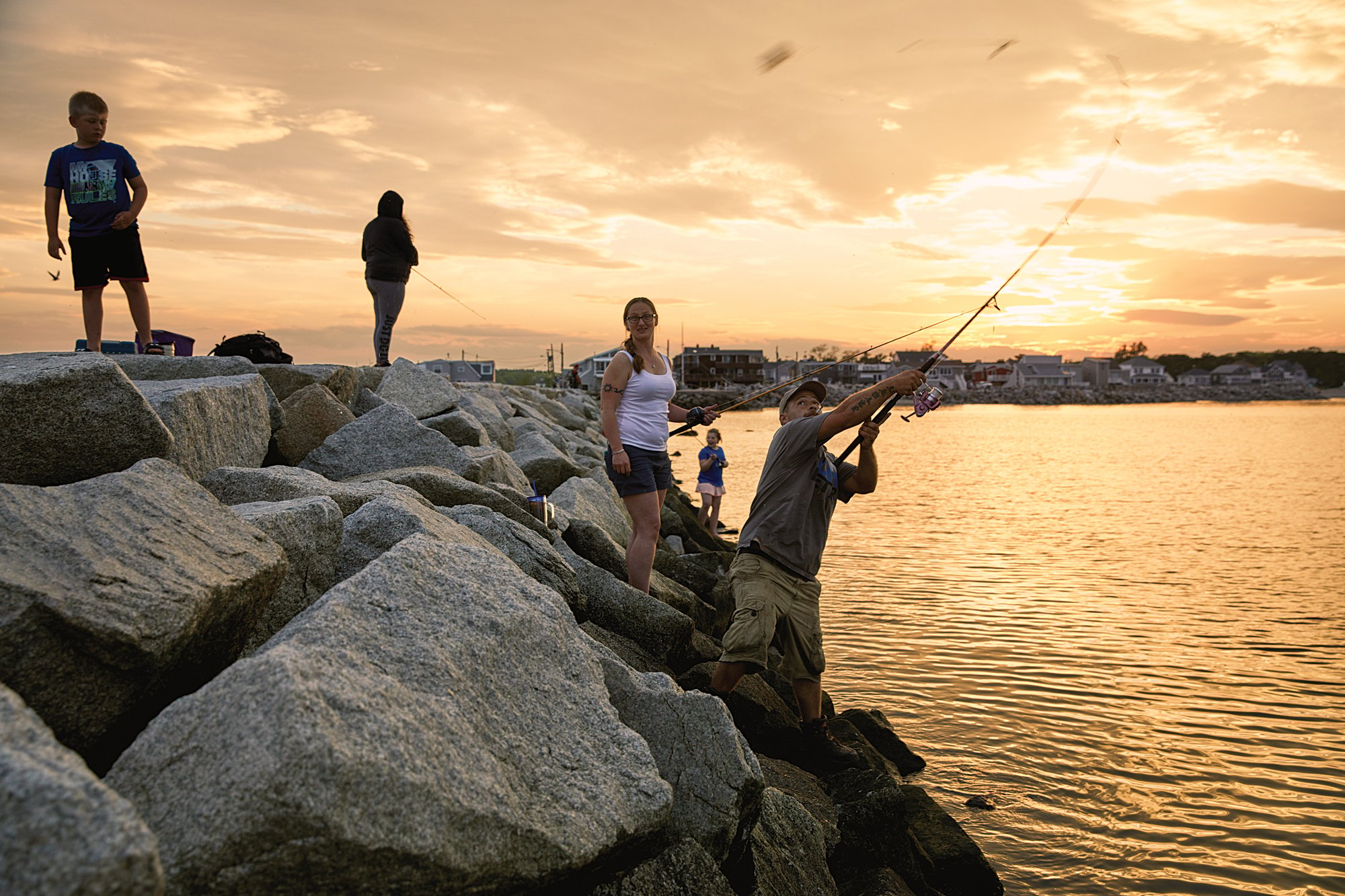
In summer, Camp Ellis moves at its own carefree pace. But beneath the sultry calm, the beach enclave is waging a desperate battle with rising seas.
By Virginia M. Wright
Photographed by Michael D. Wilson
From our August 2018 issue
[cs_drop_cap letter=”O” color=”e6b800″ size=”6em” ]n summer evenings in Camp Ellis, Midge Sanborn opens her Sea Hawk Shop at 7 and doesn’t close until the last customers go home, which has been known to be as late as 4 a.m. Those who linger into the wee hours aren’t spending all that time agonizing over the purchase of a mermaid ornament or sea-horse doorknocker. Usually, they drift in on an after-dinner stroll to visit with Sanborn, get to talking, and the next thing they know, the horizon is glowing out past Wood Island.
Sanborn dishes on her Saco beach neighborhood’s summer rituals from a picnic table at the entrance to the Camp Ellis Pier parking lot, which is bound on three sides by the Saco River estuary, sparkling now in the late-afternoon sun. Over her left shoulder, at Chevy’s Bait and Tackle, her friends Gerry “Chevy” Chevalier and Norman “Boo-Boo” Metayer sit in lawn chairs, chatting with a woman in red shorts and green rubber boots, a fishing pole clutched in her hand. Over Sanborn’s right shoulder, people hover around the takeout window of Huot’s Seafood Restaurant, waiting for their orders to be called, just as they did when Sanborn was a kid. Straight ahead is the Sea Hawk, a cabin with unglazed windows that Sanborn’s father built as an office for his seasonal fishing-charter business in the late 1940s.
“I love this corner,” Sanborn sighs. The wiry and energetic 76-year-old pushes back a strand of her shoulder-length white hair. “Camp Ellis isn’t a raving beauty of a place, but there’s something about it — it gets to you.”
When she was a girl, her family summered here, driving up every June from Belmont, Massachusetts, where her father, Don Moore, worked in the public schools. Their digs were an old hotel, the gray, three-story wood-frame building that still stands, vacant, alongside the Sea Hawk Shop. Moore took people deep-sea fishing for cod, cusk, and pollack, and by the time she was 18, Sanborn had her captain’s license and was working alongside him aboard the Sea Hawk, her gift shop’s namesake.
On hot, sunny afternoons, she and her friends would walk to the end of Beach Avenue and over the dunes, then run like crazy across the wide expanse of sand until they reached the ocean. “It was so hot on our feet, we couldn’t wait until we got to where it was damp and cool,” she says. “But you can’t do that now. All that beach is gone.”
Instead of dunes, Beach Avenue dead-ends on a bank of riprap that drops about 15 feet to a beach so narrow you can’t lay down a towel to sunbathe without it getting wet — and that’s at low tide. The steep rubble barricade extends some 1,300 feet, more than half the length of Camp Ellis Beach, from the jetty at the mouth of the Saco to a wide but short stretch of sand that today serves as the public beach.
For vacationers, the seawall is perhaps the only evidence of the severe erosion that imperils Camp Ellis, which is losing 1 to 3 feet of beach a year. But people who live, work, or own property here know summer is but a brief respite from the community’s chronic anxiety: Sand-gobbling winter storms have swept away at least 36 homes and permanently truncated eight streets over the past 60 years — and things are only expected to get worse as sea levels rise and storms become more severe due to climate change.
There’s frustration too: It took decades for the U.S. Army Corps of Engineers to recognize that the jetty it built in 1867 — and subsequently lengthened, raised, and strengthened over the next 100 years — is responsible for much of the erosion at Camp Ellis. Now, 11 years since Congress allotted $26.9 million to mitigate the problem, residents are still waiting for something to be done, their sense of urgency heightened by a powerful nor’easter that damaged homes and washed out more roadways last March.
Over at Chevy’s Bait and Tackle, Norman Metayer recalls coming in from town during the storm to see several feet of water rushing over the parking lot. “The ocean kills us,” he says. “Some years go by, no problem. But it only takes one year, one storm, like the one in March. Then the ocean comes over, and it’s mean.”
[cs_drop_cap letter=”C” color=”e6b800″ size=”6em” ]amp Ellis anchors the southern end of a 7-mile-long stretch of sandy shore that runs north through Old Orchard Beach to Pine Point in Scarborough. The neighborhood comprises less than half a square mile and roughly 170 homes and cottages, most seasonal and modest, with small yards of sand and beach grass. Some stand so close together that next-door neighbors could lean out their windows and shake hands. A handful are renovated army barracks, remnants of a temporary World War II military base. A few properties nearest to the beach are fenced by freshly constructed berms of sand planted with beach-grass culms — DIY dunes to protect against the next storm. Although home prices don’t reflect it (asking prices for some plain-looking three-bedroom houses a few blocks from the beach are between $450,000 and $550,000), Camp Ellis is refreshingly unpolished, even a little gritty, its working-class roots still on display.
“It used to be a fishing village. Everyone fished,” says Joanne Pendleton Larochelle, 86. “Today, people still fish, but the fishing families don’t live here; it’s too expensive.”
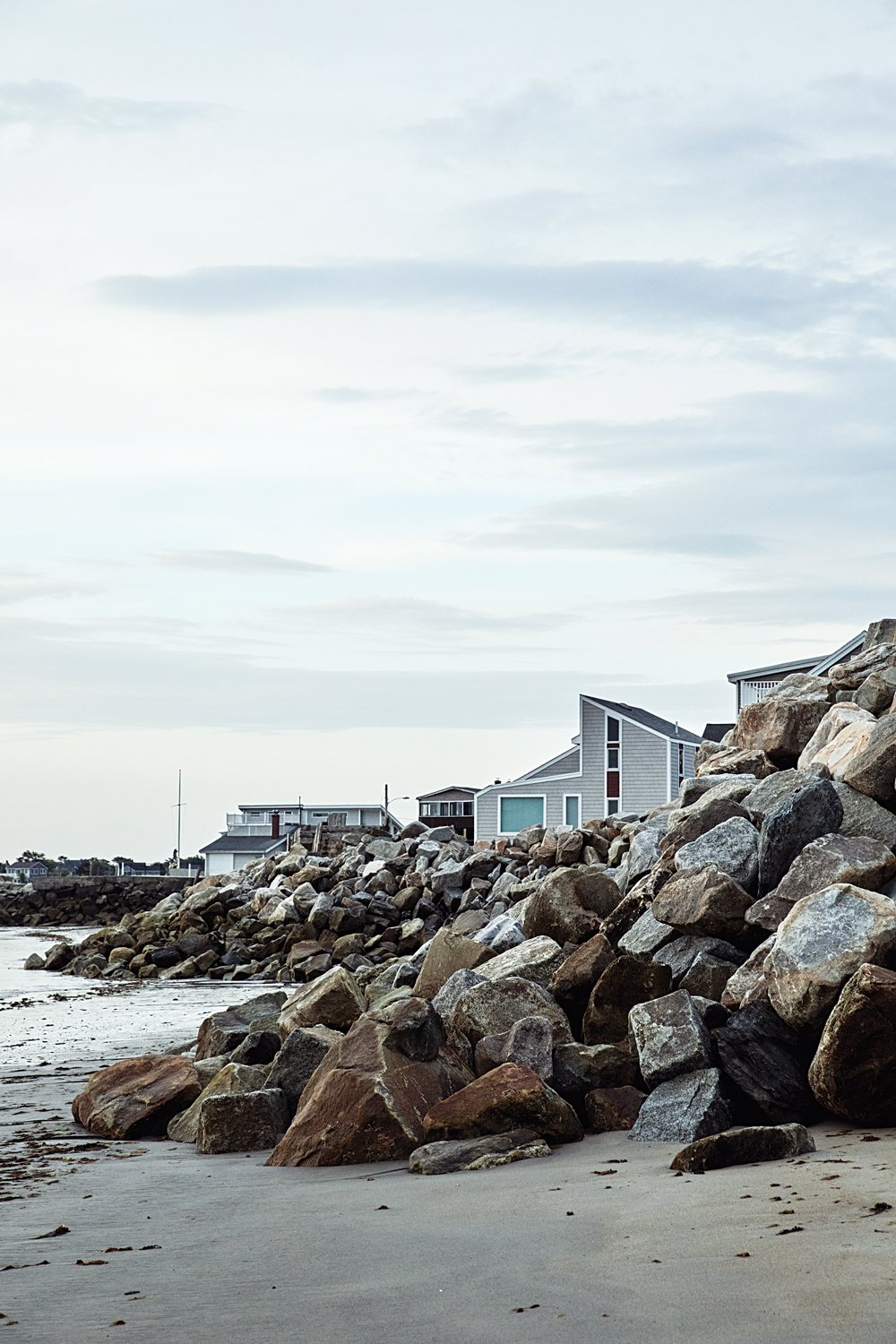
Camp Ellis’s jetty is a big draw for anglers, who fish for mackerel and stripers, but it’s also responsible for creating the destructive currents that have stripped away hundreds of feet of beach and destroyed 36 homes.

March storm aftermath: Stairs end in midair; a house buckles; wave-ravaged sand bags.
Larochelle grew up in a house that was regularly flooded during storms. Once, the waves even lifted and tilted it, but the family stayed put and rode out the gale. Today, her former home is long gone, and the land on which it stood is under water. She remembers being embarrassed to tell her classmates where she was from. “In town, they had toilets,” she explains. “Where I lived, we had outhouses.”
The hardscrabble reputation lingered for decades, says Larochelle’s 76-year-old niece, Cindy Wormwood. When she and her first husband were newlyweds, they bought an old house on the edge of Camp Ellis. “I was talking to some people in town and they said enviously, ‘Oh, you live on the Ferry Road!’ — because it’s very high-end in some neighborhoods. When I told them where, they said, “Oh, that’s the wrong end.” In the face of such slights, Camp Ellis residents developed a strong sense of loyalty to place and each other, so much so that a middle-school teacher who taught Wormwood’s children in the early ’70s wrote her master’s thesis about the locals’ solidarity. “It amazed her. She said if one kid from Camp Ellis had an issue with something in school, every kid from Camp Ellis, no matter what grade, was behind them. They stuck together like glue.”
Today, Cindy and her second husband, Colin Wormwood, are among 50 or so people who reside in Camp Ellis year-round. They live one lot away from the jetty, on the second floor of a weather-beaten house; the river mouth is their backyard. Until they reinforced it with plywood a few years ago, the building rattled and shook in every storm. “We have a million-dollar view but not a million-dollar house,” she admits. “I think it’s the most gorgeous place in Saco.”
“If one kid from Camp Ellis had an issue with something in school, every kid from Camp Ellis was behind them.”
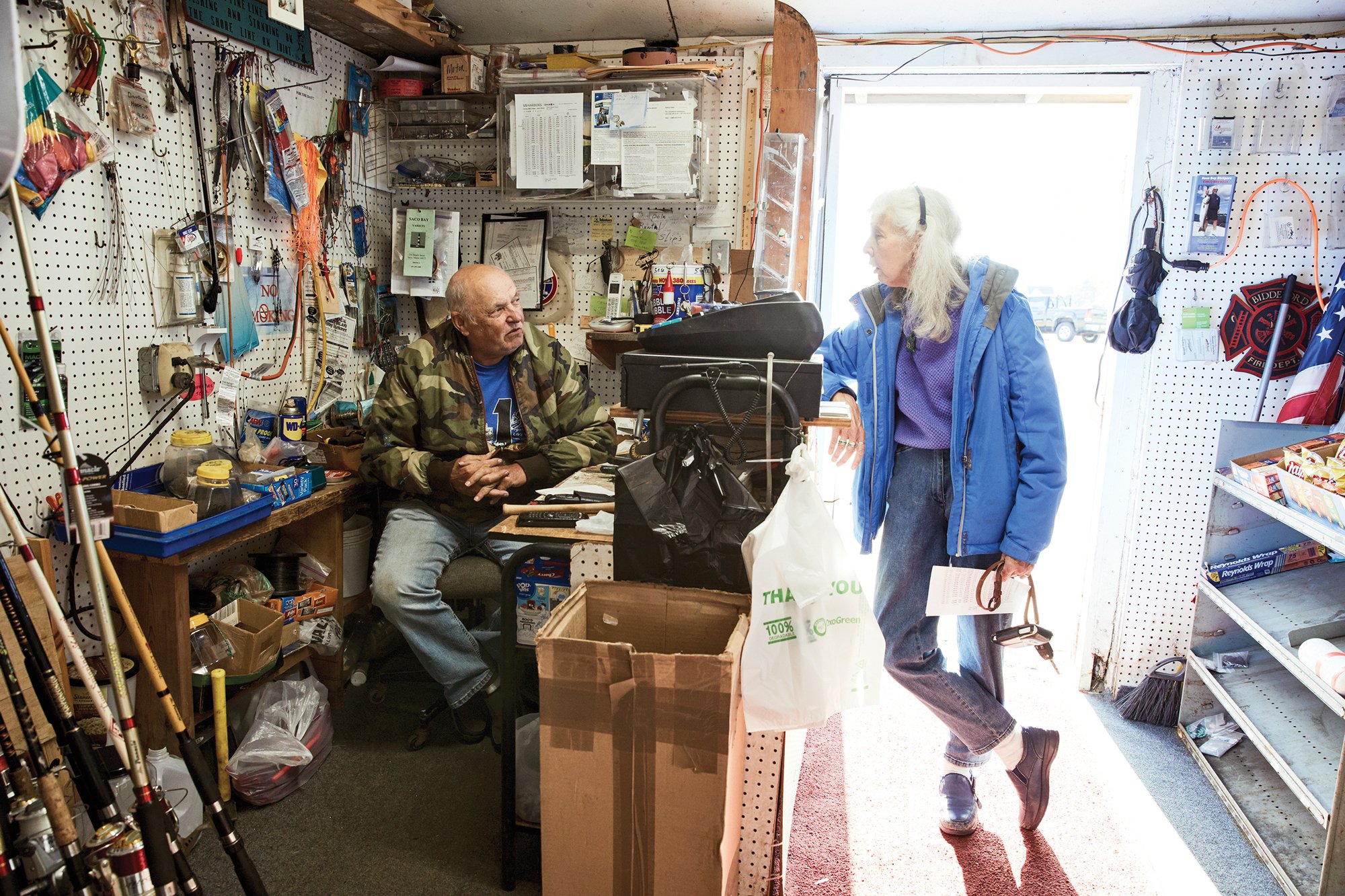
Midge Sanborn chats with Gerry Chevalier at his bait and tackle shop next to the Saco River. Saltwater fishing is one of Camp Ellis’s chief attractions.
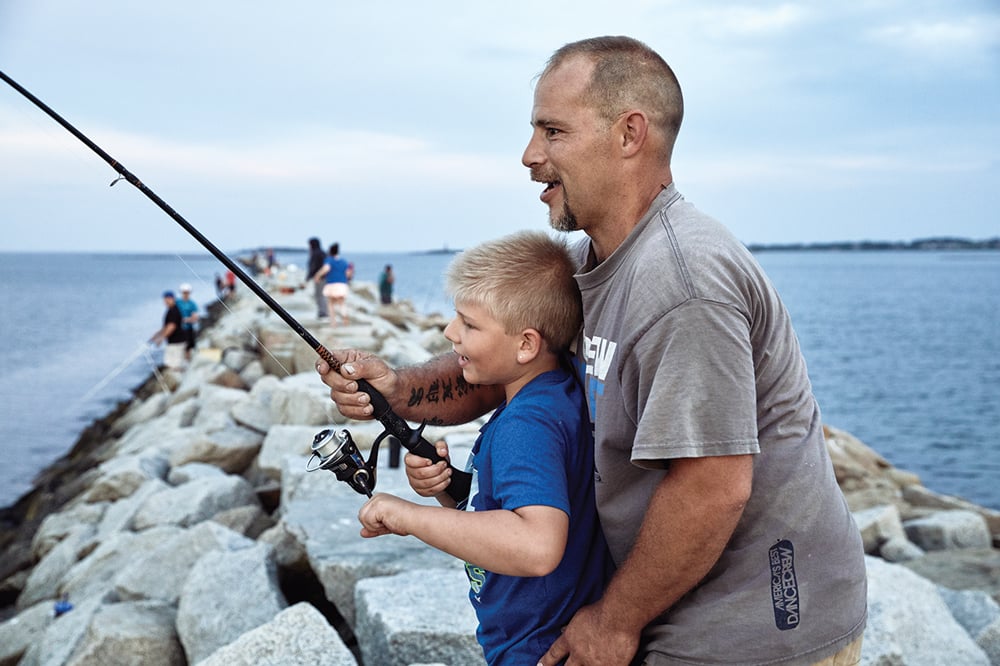
Though it’s largely a seasonal community today, Camp Ellis retains the flavor of the fishing village and workingman’s beach retreat it was for most of the 20th century. Most houses and cottages are modest and vintage, and the harbor hosts a robust commercial fishing fleet, which is rare in southern Maine, where fishermen have typically been crowded out by recreational boats. Maine’s most vulnerable coastal community, Camp Ellis is distinguished by its long riprap seawall. In early summer, public works crews and residential contractors were still cleaning up after a destructive March nor’easter.
[cs_drop_cap letter=”B” color=”e6b800″ size=”6em” ]esides the beach, Camp Ellis’s chief attractions include the river harbor, populated by lobsterboats, pleasure boats, and fishing charters; the 6,600-foot-long rock jetty, where anglers cast for mackerel and stripers; and Huot’s Seafood Restaurant, an 83-year-old institution. Though it’s just 4 miles east of downtown Saco and busy Route 1, Camp Ellis feels like a secret hamlet. “If you don’t know it’s here, you won’t just happen upon it,” says Huot’s 51-year-old owner, Denise Gelinas, who’s worked since she was 10 at the restaurant founded by her grandmother. Day-trippers are usually locals, she says, and cottage owners often have multi-generational roots. Even the weekly renters tend to be the same faces year after year.
And so, it seems, everyone knows everyone else. Midge Sanborn is the matriarch, holding court at her souvenir shop evenings from early July to Labor Day, just as she’s done every summer since the mid-1960s. The hours suit a neighborhood that places a priority on swimming, boating, and fishing. Sanborn’s known many of her customers since they were kids; today their grandchildren stop in before bedtime to get a hug. “I’m here for the people who want to buy gifts,” she says, “but if they come in just to visit, that’s fine with me.”
“When you go for a walk in Camp Ellis, you say ‘hello’ to everybody, and sometimes the walk will last all day,” says Susan Calderone, a seasonal resident for 30 years. This summer, she’s helping her friend, Ellen Coniaris, continue the tradition of “Black Beach,” which started spontaneously several years ago when Coniaris and her husband, Dean, began selling their lobster catch out of their garage. People strolling by evolved into people stopping to chat and eventually into people arriving with lawn chairs, beach umbrellas, and hors d’oeuvres, settling in for a few hours on the Coniarises’ driveway, which they dubbed Black Beach.
That’s the spirit that Ellen, a Kennebunkport native, fell for 24 years ago when Dean introduced her to his family’s summer home. “I loved it instantly,” she recalls. “I loved the small-town feeling. I loved the way people waved to us when we walked down the street.”
This is Ellen’s first summer of lobstering without Dean, who died of a heart ailment in March, the same weekend of the storm. Dean often called himself the Fish’n Optician, because that’s what he was: a lobsterman who also had a job making and supplying eyeglasses. His friends called him “the mayor of Camp Ellis,” in part for his service on town boards and citizen organizations working to find a solution to Camp Ellis’s erosion problem, and in part for his gregarious nature — he brought people together. In the weeks after he died, his friends came together again to help clean up the Coniarises’ cottage, which flooded when waves breached the riprap wall. “In all the time I’ve been here,” Coniaris says, “that storm caused the most damage I’ve ever seen.”
Ellen Coniaris tends to her lobster traps; Boo-Boo Metayer at Chevy’s Bait & Tackle, which sat so high on stilts 50 years ago that a kid could walk under it — sand has since filled in the space; mackerel caught by an angler on the jetty; an abandoned section of Surf Street, thousands of feet of which have been washed away by storms.
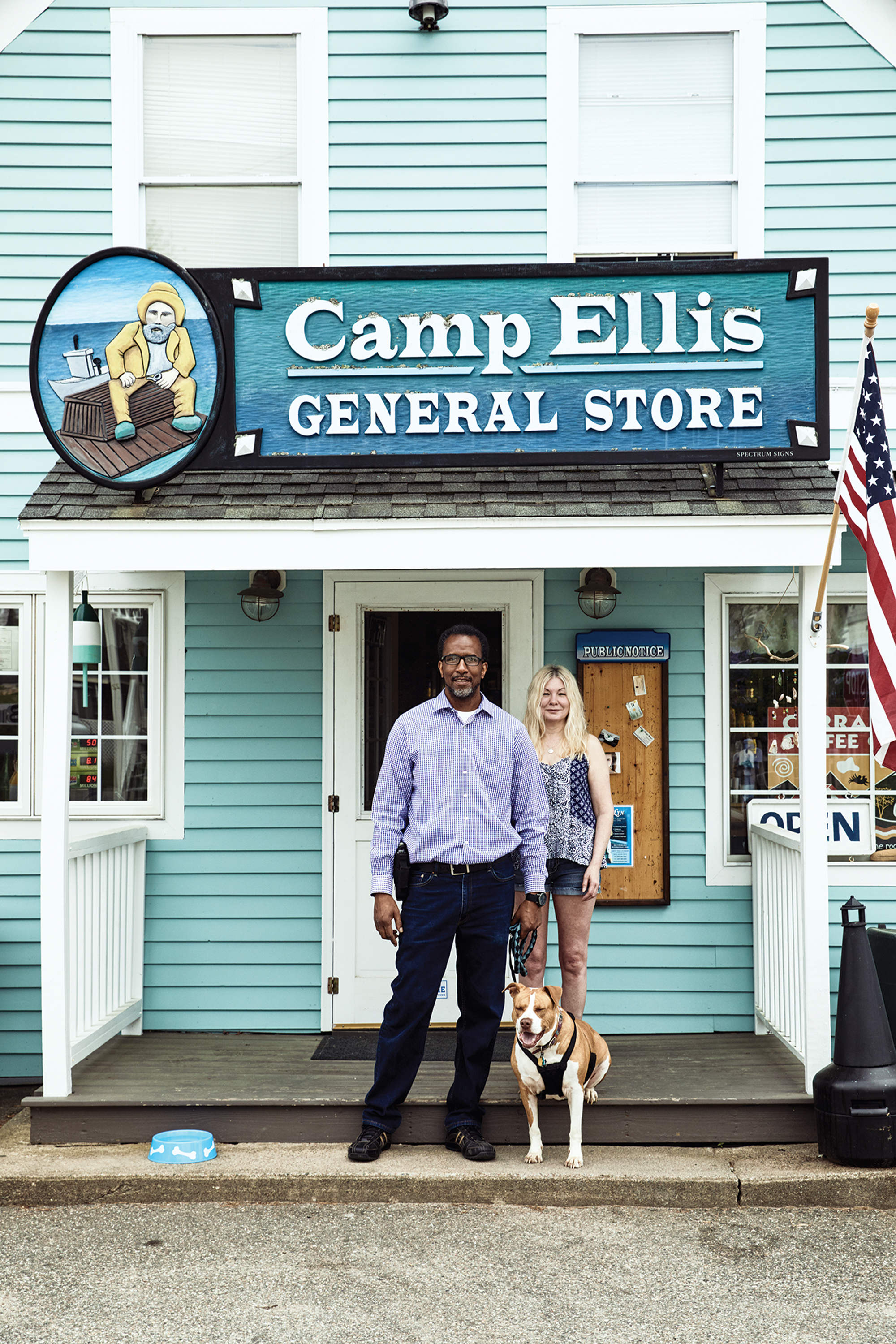
General store owners Dwayne Singletary and Kathy Lovely.

Saco harbormaster Dan Chadbourne.
[cs_drop_cap letter=”T” color=”e6b800″ size=”6em” ]he March storm battered the Maine coast for six days. All of coastal York County suffered, but Camp Ellis and neighboring Ferry Beach got the brunt of it. The ocean washed away roads, damaged more than a dozen houses, and tore apart 200 feet of geotubes, large sandbags buried in the beach seven years ago to protect the shoreline.
“For most people, the most recent measure of a terrible storm was the 2007 Patriot’s Day storm, which destroyed three homes and resulted in the permanent abandonment of a section of Surf Street,” says Saco director of public works Patrick Fox. “In some ways, this one in March was worse. The 2007 storm lasted four tide cycles. This one pounded the coast for 12 tide cycles, each one another chance for it to eat away a dune, take a road, take someone’s front porch, or a seawall. And it did. With only 12 hours between each tide cycle, there was no chance to put any protective measures in.” The cost of the damage to Saco’s public infrastructure alone was $650,000.
Even in years without punishing storms, patching up Cape Ellis’s shore is expensive, about $300,000 a year, more than Saco’s entire budget for winter road clearing. “What other communities would consider a crisis, we deal with four to five times a year,” Fox says. “Saco has the most erosive coastline in the state of Maine.”
Some of that’s due to rising sea levels — nearly a foot in Maine over the past century — and Camp Ellis isn’t the only coastal community to feel the effects. But Camp Ellis’s difficulties have been greatly exacerbated by the jetty, which was built to prevent sand from accumulating in the mouth of the Saco River, allowing ships to reach Biddeford’s textile mills without running around.
“In all the time that I’ve been here, that storm caused the most damage I’ve ever seen.”
“Clearly, the modeling technology of 1867 was not what it is today,” says Saco city administrator Kevin Sutherland. “They thought the current moved in a counterclockwise direction, depositing sand at the river’s mouth. In fact, the current was moving clockwise, putting sand on the beach. Now, the ocean hits the jetty, picks up speed, and scours the beach, sending the sand north, most of it to Pine Point in Scarborough. About 20,000 cubic yards of sand that would naturally come down the river and go around to replenish the beach every year can’t get around the jetty.”
The erosion is advancing northward, and unless something’s done to slow it down, neighboring Ferry Beach, which was hard hit in March, will soon be losing sand at Camp Ellis rates.
If there’s a silver lining to the March storm, it’s the attention it brought to Camp Ellis’s plight at a time when Saco officials, along with Senators Angus King and Susan Collins and Representative Chellie Pingree, have been ramping up the pressure on the Army Corps of Engineers. In May, the agency finally drafted a recommendation for how to use the $26.9 million that Congress authorized for erosion mitigation in 2007. The proposal — a 750-foot spur jetty extending perpendicularly from the existing jetty — is the most affordable of 26 options the corps reviewed. (Removing the jetty, which could devastate Biddeford’s coast to the south, was not one of them.) The spur would shield the shore by breaking up the destructive currents, but it’s not a panacea. “With the spur, the beach should last 10 to 12 years, then it will need to be re-nourished,” Sutherland says. “It’s a temporary fix until we can find a more permanent solution, but it’s our only option if we’re going to do something with the corps, and our best option with the resources that we have.” If the project breezes through the approval and permitting process — which, given the history, seems unlikely — the soonest the work might begin is 2020.
In the meantime, Camp Ellis will get some temporary relief from a dredging project in the Saco River. Instead of depositing the dredged material offshore as usual, the corps will pump it onto Camp Ellis Beach, beginning at the jetty and working northward. It’s a lot of sand: 78,000 cubic yards, or roughly 4,000 dump-truck loads, enough to cover the riprap. “We’re predicting a beach width of 100 feet,” Craig Martin, a corps project engineer, told residents at a public meeting in May. “We expect it’ll last four to five years, but it’s dependent on storm activity. Basically, it’s a Band-Aid.”
“Now, the ocean hits the jetty, picks up speed, and scours the beach, sending the sand north.”

Decades ago, there was a wide sandy beach where there’s now a rubble seawall.
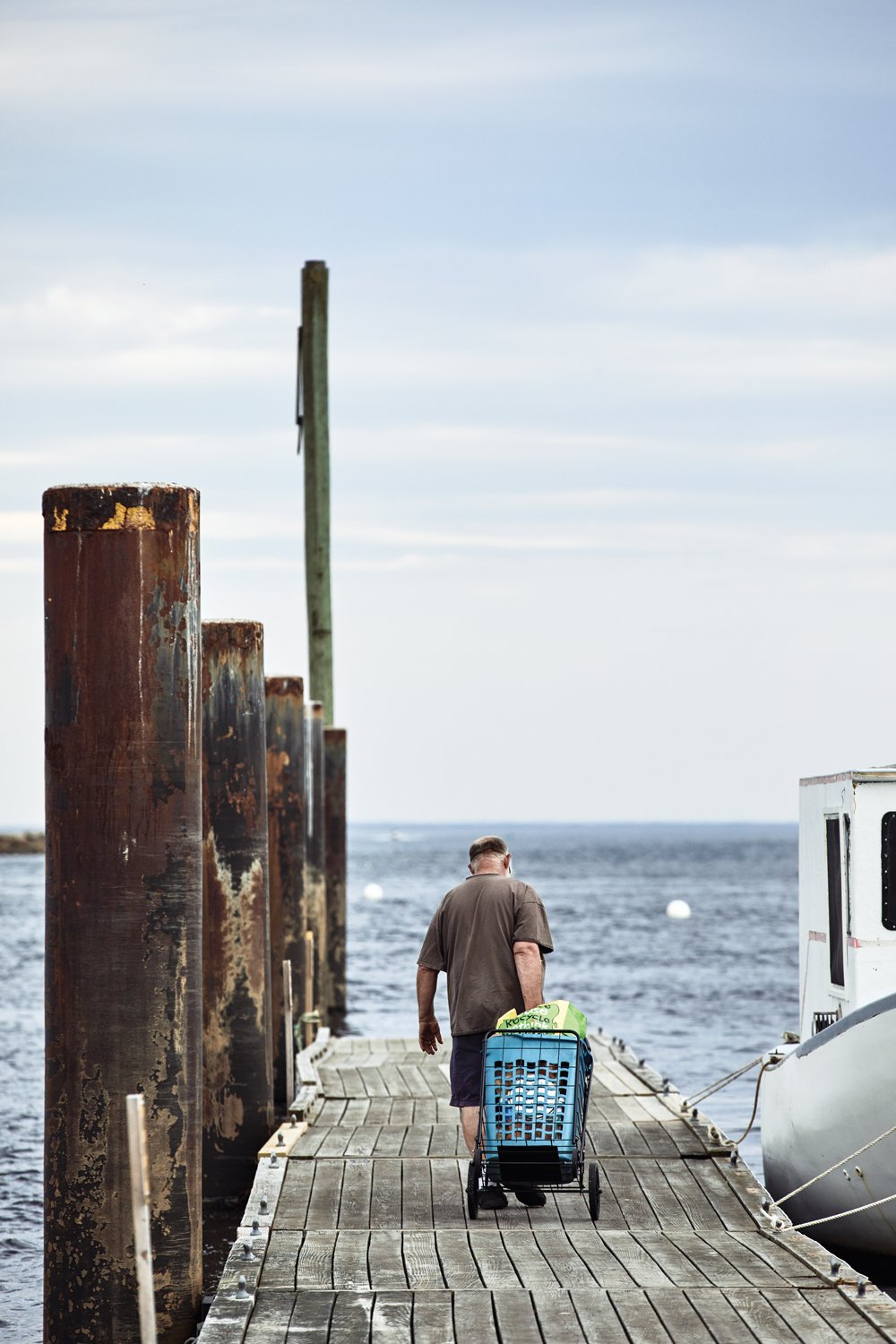
A boater walks his supplies down the Camp Ellis Pier.
“Friends called Dean Coniaris “the mayor of Camp Ellis,” for his work to save its shores and for the way he brought people together.”
[cs_drop_cap letter=”C” color=”e6b800″ size=”6em” ]indy and Colin Wormwood never considered leaving their home during March’s nor’easter. Staying put has always been their practice. Before they retired, it was because they wanted to guard against looters entering their restaurant, Wormwood’s, across the street. The restaurant’s gone now, nothing to worry about, yet still they stay, brushing off their children’s advice to find shelter inland when the forecast calls for dangerous weather. “I tell them, ‘We live on the second floor. If the water reaches us, then we’re all in trouble!’” Cindy says, laughing.
Looking out the window that faces the jetty, Cindy points to the seawall that usually holds back the Saco River from the couple’s tiny yard. But in March, the river churned like never before. Waves spilled into the yard, draining nearly all the soil from her garden. It was a mess, she says, but the couple was lucky compared to what others suffered.
Winter in Camp Ellis is an experience that binds residents together just as classism once did. They’ve seen houses fall into the ocean, refrigerators floating in the streets, and people being evacuated from their homes in rowboats. “When a storm is coming, everybody checks up on each other — they make sure you’re okay and that you don’t need anything,” Cindy says. She gestures out the window again, this time at her neighbors. “Camp Ellis people are stoic and tough. They know the ocean, and they know what to expect.”















